
Aside from being an international shipping port, the stunning cityscape of Savannah, GA, is said to be the most haunted place in the US. By day the city is a quaint tourist attraction. But by night, the little city of Savannah comes to life with historical ghost tours daring to share the legends of those who built their town.
But where are those legendary locals buried? And what stories do they share from their graves?
Historical Bonaventure Cemetery
The historical Bonaventure Cemetery ranks as one of the most beautiful cemeteries in the US. And with it’s towering tree tunnels and swaying Spanish moss, I can certainly see why.
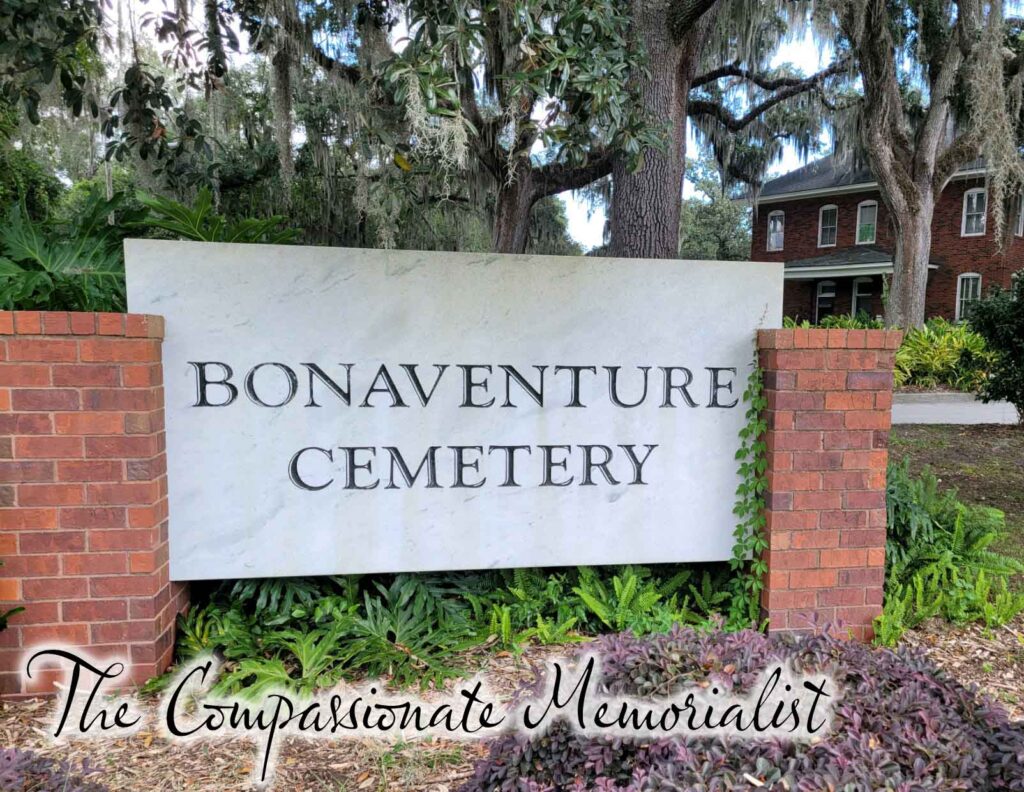
Founded in 1846, this Victorian Garden Cemetery hosts a stunning collection of memorials. The Victorian Era revolutionized the way we honor loved ones. Rather than forget a deceased loved one’s existence, they chose to incorporate it into their daily lives. The cemetery became a place where family and friends could gather and picnic, all while including their loved ones.
The result of this era is one we still enjoy today. Victorian Garden Cemeteries feature individual family gardens featuring structurally unique memorials or sculptures. Each memorial is unique and is adorned with meaningful symbols. These symbols have been carefully curated by the sculptor and the family to share their deceased loved one’s stories beyond the grave.
Cemetery Symbolism
Symbols have been used in memorialization since the beginning of time. They convey a message in just a few simple images as opposed to lengthy, space-consuming text. And the symbolism in this cemetery did not disappoint.
In fact, there is so much cemetery symbolism here, that I need more than just one blog post to cover it all!
Grimm Memorial
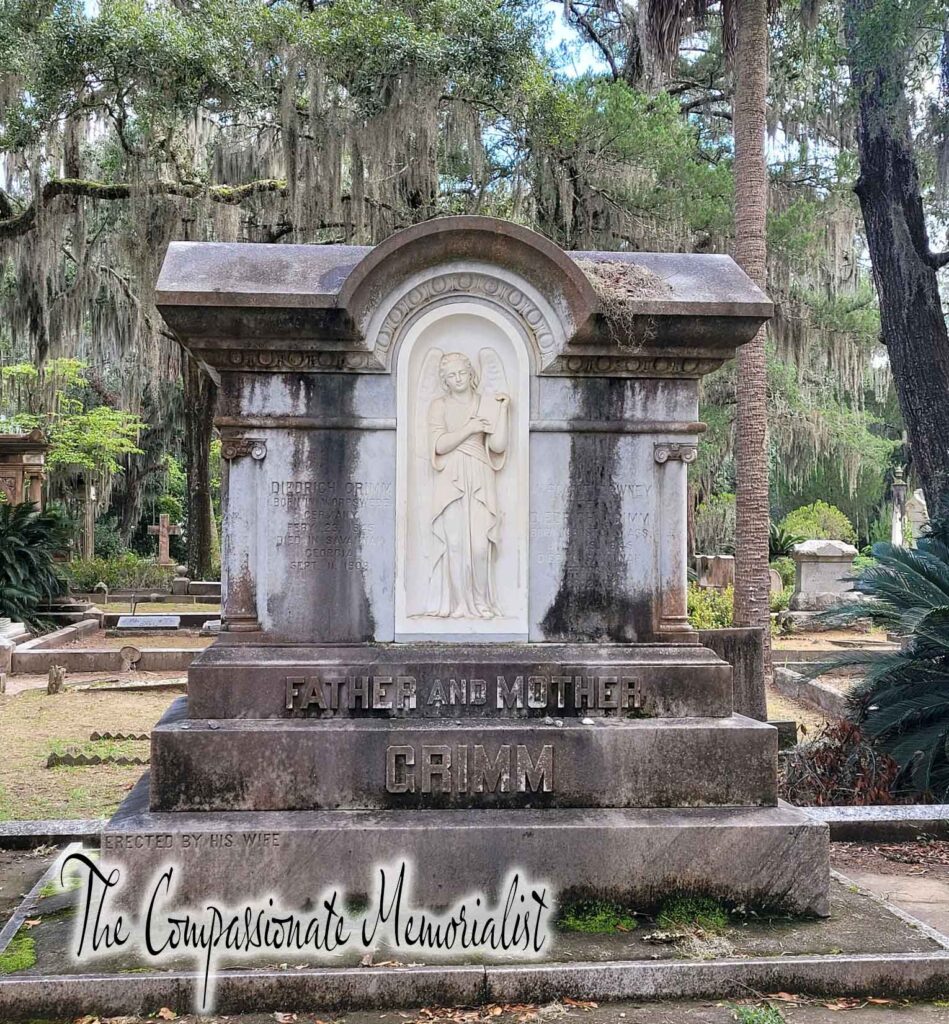
What a beautiful one this is! And with such subtle cemetery symbolism to tell their story. One thing I had not noticed while in the cemetery was the carving on the lower left side of the base. If you look above my added logo, very faintly, you will see “Erected By His Wife”.
You may initially think it beautiful that she wanted all the world to know that she chose and commissioned this timeless tribute for her husband. But…what was the real reason behind this inscription?
The Mysterious Case of the Wife
At first thought, you may believe this text is of historical importance. This memorial was erected in the middle of the Women’s Suffrage movement. During this time period women were pushing to have social, economic and political equality. Female supporters of this movement wanted to show their female counterparts that, YES, they can do anything.
On this memorial she could have chosen to inscribe “Erected by Margaret Downey Grimm”. However, she chose to specifically state it was erected by “His Wife”. So this could be a nod to gender roles and Women’s Suffrage.
But…is that really the reason? My theory is that it is not.
Margaret Grimm wanted all the world to understand that she was the wife of Diedrich Grimm. You will notice on the right side of the angel where her name and dates of life are inscribed. Notice it specifically states that she is the wife of Diedrich Grimm. She then takes this fact of identity one step further and inscribes “Father And Mother”.
She specifically does not leave any of this information up to assumption and I believe that is very intentional.
A search on Find-A-Grave indicates that Diedrich Grimm had had two wives. Neither wife preceded him in death, which leads one to believe he was divorced.
Divorce was uncommon during this time period and usually shockingly scandalous and expensive. Keeping that in mind, Margaret may have chosen to inscribed “Erected By His Wife” along with the text indicating she is his wife to ensure that no one is mistaken.
The Artist’s Signature
On the opposite side of the base you will notice a subtle yet famed signature. It is none other than that of John Walz. It is longstanding tradition for artists to sign their work. And, of course, commemorative art is no different.
John Walz is a famed German sculptor who made his home in Savannah, GA. His work is seen throughout Bonaventure Cemetery with a lane dedicated in his honor.
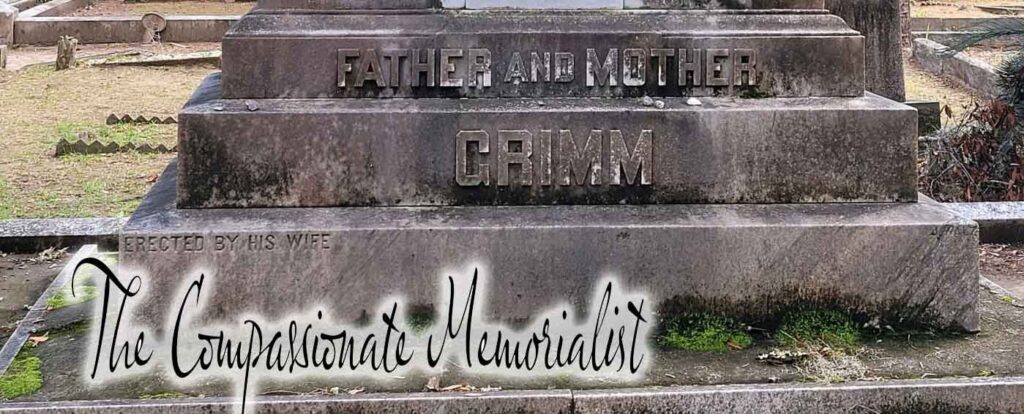
The Classic Lettering Style
Looking up to the next sub-base, you will notice the beautiful raised lettering for their last name, Grimm. Raised lettering is a classic technique that allows letters to appear eternally bold and beautiful.
On top of the sub-base (just above the last “M”) you will notice some dispersed pebbles. While it may be easy to assume they are debris, they are actually very meaningful! In cemetery culture, and most commonly Jewish culture, it is an act of remembrance to place pebble or stone on one’s memorial when you visit.
The Memorial Symbolism
Looking up at the tablet (top part), I am amazed by the cemetery symbolism. First you will notice the white marble inset featuring a bass relief carving of the angel holding a scroll. Scrolls symbolize mortality with their defined beginning and a defined end. It is interesting to me that nothing was inscribed on the scroll.
The second cemetery symbolism you will notice is the carved columns on the far left and right hand side of the angel. What I find interesting about these columns is that the artist used Tuscan style columns (with no fluting running vertically on the shaft) in combination with Greek Ionic style capital. You may recall this post where I explained Tuscan columns.
The mixture in column styles is incredibly symbolic. You see, architecture has an “order” of structure. Columns seen on buildings typically adhere to the “Roman Order of Architecture”. The Romans had initially created the Doric, Ionic and Corinthian orders and then later combined the styles to create the Tuscan order.
The Victorians had revived architecture and use orders more for ornamentation as opposed to strictly structural purposes. The combination of orders in the carved columns is a nod to the deceased not being confined to traditional cultural norms or values.
J.A. Schafer Memorial
This memorial features so much cemetery symbolism, that I don’t even know where to start! What a gem of a find!

This memorial initially caught my eye due to the tree trunk. You will notice the tree trunk is tall and appears to be cut at an area of growth. If you look closely you will notice it appears that the last name SCHAFER is carved into the trunk that is wrapped in ivy.
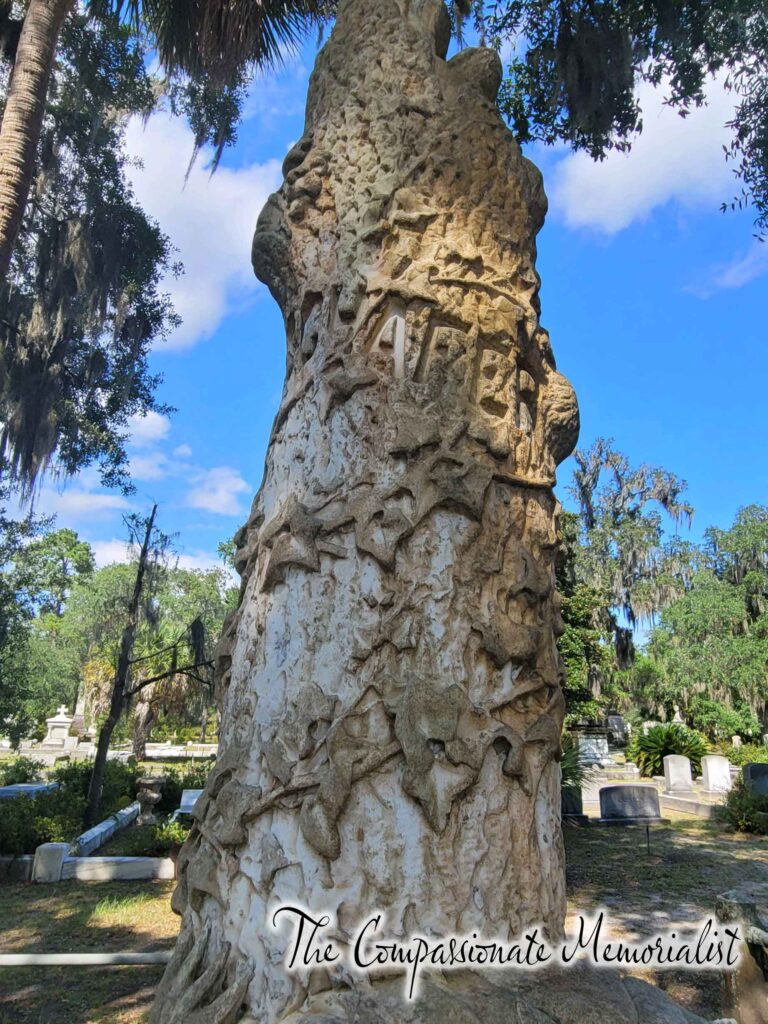
There is so much symbolism in the tree trunk alone! The tree trunk itself commonly represents a life cut short. However, the stone lists J.A. as being 71 years of age when they passed away. Given their age, I am not convinced this was the intended interpretation.
The shape of the tree is interesting, with the trunk being fairly long and bark extending up to a certain point of new growth. The fact that the name is carved into the trunk along with the tree shape leads me to believe they are indicating the family (past along with the deceased) laid a solid foundation for future generations. I believe the ivy, which typically represent eternity, indicates the cycle of the foundation will repeat indefinitely.
Underneath the tree trunk we see even more symbolism! Seriously, this monument is a dream come true! Look at all of that!

The Surprising Story Of The Hour Glass
The very first thing that caught my eye was that hour glass. I had never seen an hour glass incorporated into memorial design before and was thrilled to notice this gem!
If you look at the hour glass up close, you will see that the curtain is draped over a portion of the hour glass. Additionally, there is some texturing behind the hourglass and extending out to it’s sides. If you allow your eyes to follow the texturing on the left, you will see that this texturing is actually wings! It is a flying hourglass! What a find!
I cannot tell you how incredibly lucky I feel to have found such a beautifully carved flying hourglass in the cemetery.
Hourglasses, often called “sand clocks”, were a staple item in every Victorian home. They measured increments of time in intervals of thirty or sixty minutes, and everyone had one. Because everyone had one, it was commonly understood that the “sands of time” did eventually run out. Thus, the hourglass became symbolic of one’s time on Earth running out.
In fact, the Victorians associated the hourglass with death so much that, it was not uncommon for them to be buried with an hourglass! As the deceased lay in their casket, gripping an hourglass across their chest, it represented to onlookers that their time on Earth had expired.
I do wonder if JA Schafer had been buried with an hourglass. Maybe…maybe not. We will never know!
Given their symbolic meaning, hourglasses became popular cemetery memorial symbols. Eventually winged hourglasses became even more popular as it represents that “time flies”.
The Hourglass and the Curtain
What fascinates me even more about the hour glass on the JA Schafer memorial is the fact that it is partially covered by a curtain. Curtains are interesting symbols. Curtains commonly represent the veiling that separates our passage from our Earthly realm of life into our Eternal realm of life.
You will also notice the palm leaf in this group of symbols. Notice how one of the leaves overlaps the wing on the hourglass. The palm leaf is a Christian Symbol that represents Palm Sunday and Christ’s victory over death.
You will also notice the hint of ivy in the very background of this symbolic grouping. It is ever so slight, but it is important to the overall message.
Having the trailing ivy, the palm leaf overlapping on top of the winged hourglass and the curtain all tied together is incredibly meaningful. It means that this individual’s Earthly life flew by, but they will conquer death by passing into Eternal Life.
The Delicate Name Panel

Isn’t this part of the memorial stunning? I have not made up my mind on whether this figure is a scroll or a shield. Or maybe it is something else. I am leaning toward it being a shield but am certainly open to ideas.
I find it interesting how ferns were used on the right hand side but, on the lower left the leaves do not appear to be those of ferns. This would have been intentional, as the use of one single fern may represent victory over death. However, the use of two ferns may symbolize a struggle.
I am not entirely sure what kind of leaves are poking out in the bottom right corner. Likewise, I am not certain about the use of the filigree on the top right. These two symbols have me stumped!
Given that I am unsure of the scroll, leaves and filigree, I just have to admit that I don’t know the meaning behind this part of the memorial. I love the cursive and the beauty of this entire piece and would love to know your thoughts on it’s symbolic meaning!
The Artist
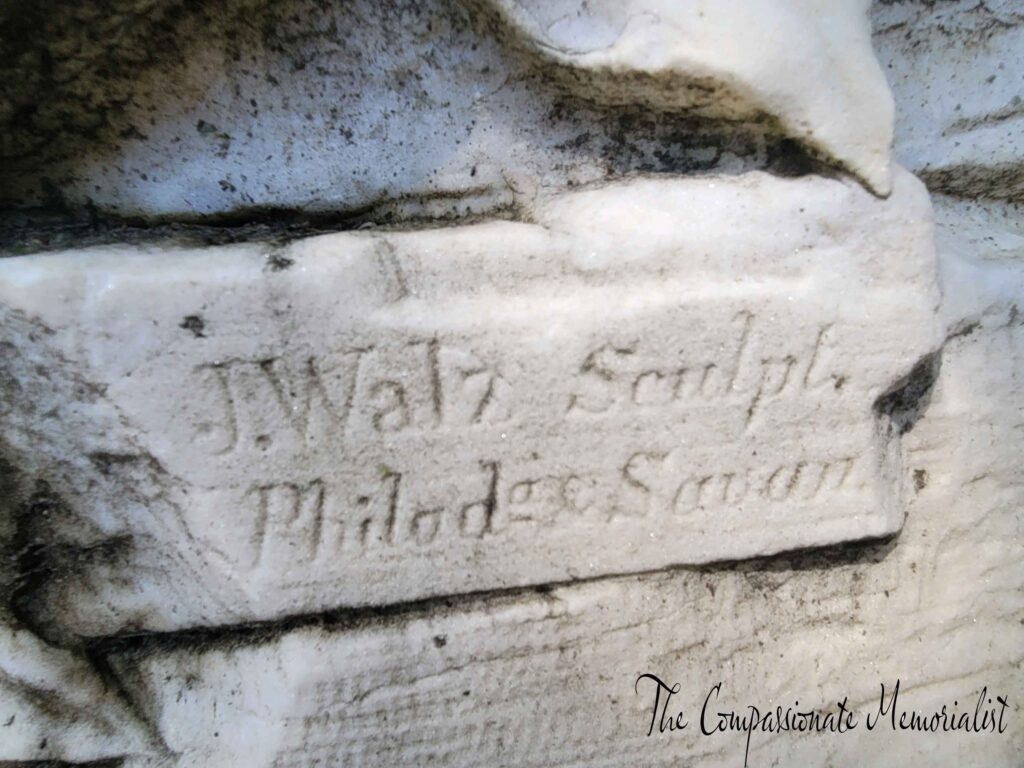
This stunning memorial was carved by famed German sculptor, and Savannah, GA, resident, John Walz. You will notice how he indicated in his signature “Sculpt.”, abbreviating “sculptor”.
Underneath his name and title you will notice additional text. I had trouble making out the text, but the Savan at the end is short for “Savannah”, the city in which it was carved. You will commonly see him sign his name on his work with Sav after his name in reference to the city.
In this case I do wonder if he abbreviated Savannah differently on this memorial, or if he had spelled out Savannah with part of it having been chipped off. You will notice a corner of the memorial has chipped there.
I have tried to determine what the text underneath his name and title of sculptor means. I have searched it and am unable to come up with results. What are your thoughts on what that says?
Let Me Know Your Thoughts!
I absolutely love cemetery symbolism. Do you interpret the symbols on these stones differently? Can you identify the text/name underneath John Walz’s signature? Drop me a line and let me know how you interpret them!


2 Comments
Hi Alison! What a great read! I thought I’d shed some light on your symbolism mystery! I am a historian in downtown Savannah and have spent most of my research time on Bonaventure Cemetery. The leaves on the top right are oak leaves, Which suggests that the stump is an oak tree! The fern itself is a Resurrection Fern, which is found at the bases of many oak trees here in Savannah! The symbolism of an oak tree being cut short is to portray the family’s loss of their head of household, similar to the broken pillars also found in Bonaventure. The oak itself highlights the strength of Mr. Shafer. while the leaves on the bottom right are those of a Laurel Tree, and could either signify his success in life or could pay homage to the geographic location of his resting place!
Thank you so much for taking time to share your knowledge!! Mr. Shafer’s memorial is beautiful and I am thankful you could shed some light on the meanings of the symbols!